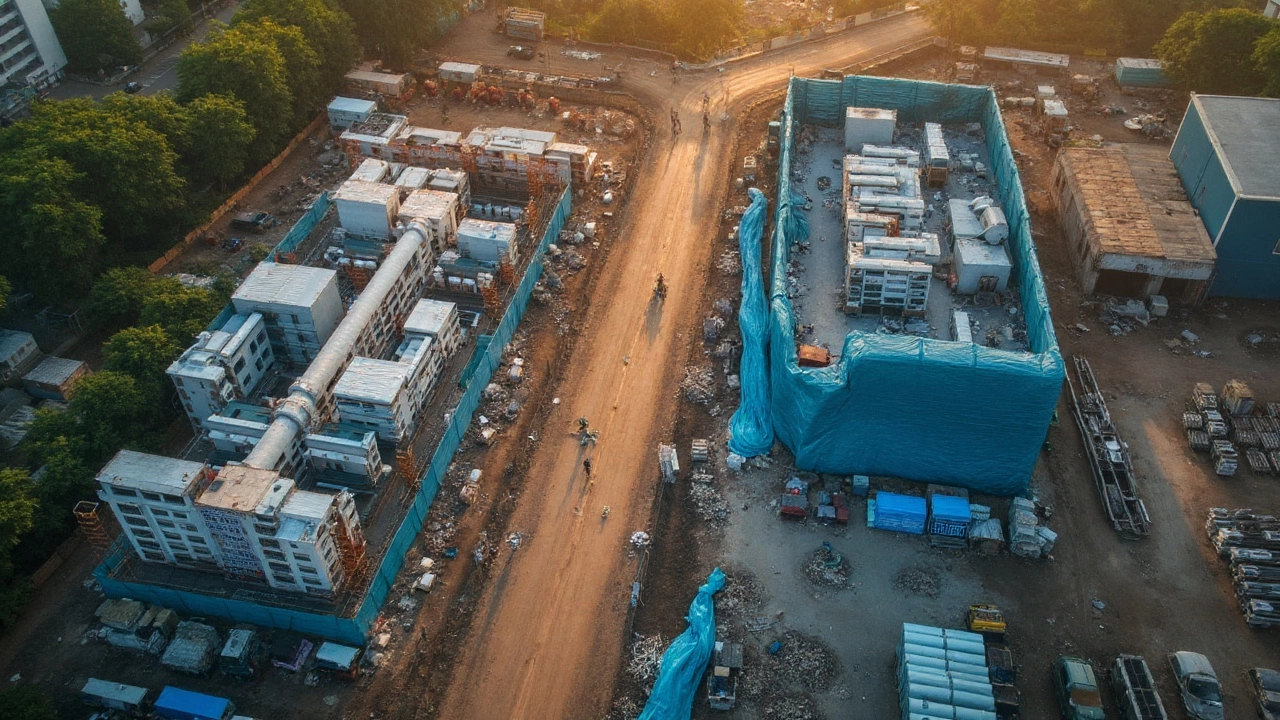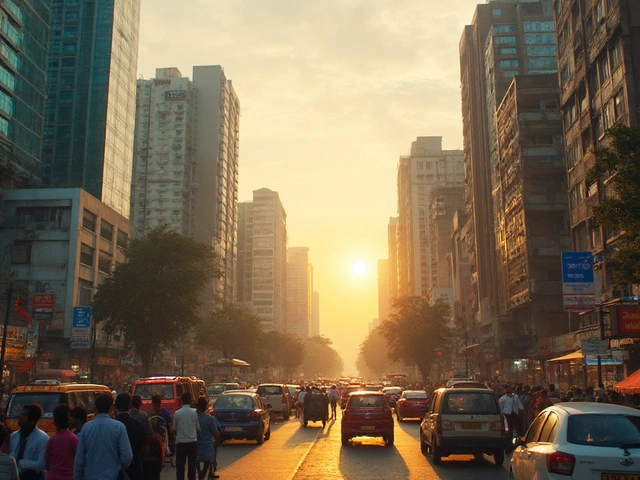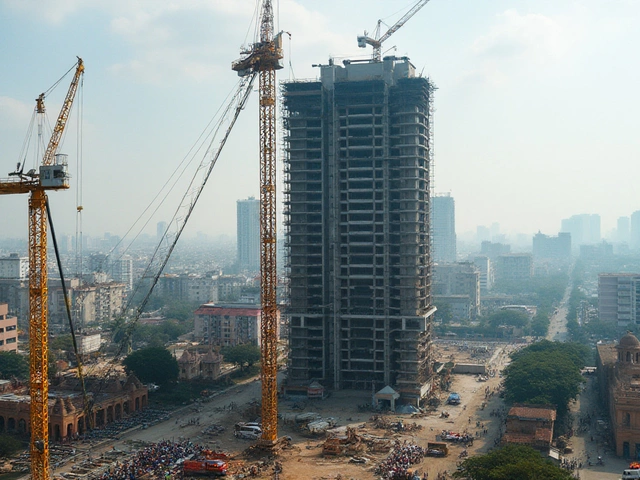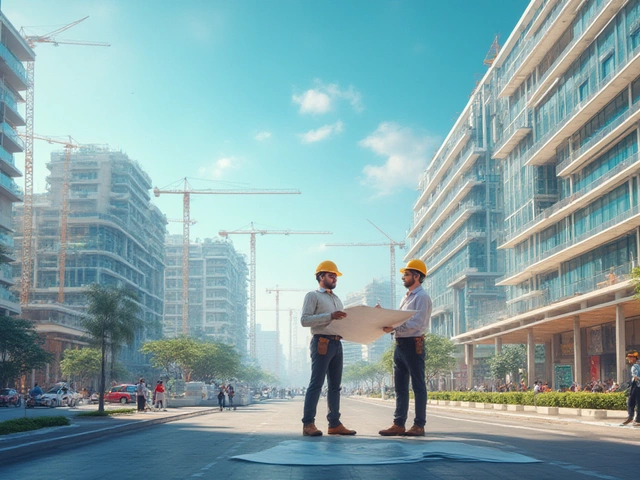Picture a shiny new shopping mall bustling with coffee shops and bookstores on one side of town, while across the highway, a steel-frame warehouse hums with robotic arms and forklifts. Both are products of construction, but they live in totally different worlds. Most people lump them together, calling anything big and boxy “commercial.” That’s like calling a vet and a chef the same because they both wear aprons. The truth is, commercial and industrial construction are different games with unique rulebooks—and knowing the difference matters whether you’re hiring a builder, working in the field, or just trying to impress your father-in-law at dinner.
Commercial Construction: Building for People
Think of commercial construction as anything designed for humans to work, shop, dine, or get a haircut. Malls, restaurants, banks, bakeries, schools, hotels—these places make daily life tick. The main focus for commercial builders is people. Even a small mistake in a hospital lobby’s design can trip up dozens of visitors a day. Codes get strict: easy navigation, wheelchair access that actually works, fire escapes nobody hopes to use but everyone wants to see. Lighting, soundproofing, comfort—it all has to flow together.
Commercial projects tend to pop up in cities, downtown clusters, or wherever lots of folks are moving around. Some cities require minimum parking spots per square foot. Others demand artwork in the lobby—seriously, check out the Seattle “1% for Art” rule. Think also about the speed. Developers want shops open before the holiday season, or banks launching with the new year. Instead of years, the average commercial build (like a fast-food restaurant) may finish in just months if weather and supply chains play along. If you want numbers, the Associated General Contractors of America pegged the average size of a commercial project at just over 14,000 square feet in 2024, with a cost running between $250 and $400 per square foot for something like office space.
I’ll be honest: in a commercial space, it’s all about flexibility. You design for tenants who may change their minds—or even the entire use—every few years. Today, it’s a clothing shop; tomorrow, maybe an escape room or tech startup. So walls, plumbing, and network wiring need to be easy to rework. That’s a huge tip: if you’re building or leasing, ask about “future-proofing.” Extra conduits or reinforced beams sound boring but could save a fortune if you want to convert the space down the road.
One funny story: my wife Lydia and I once visited a hotel where the hallways were so twisty, even the bellboy got lost twice. Turns out, the contractor had to improvise when the city demanded extra fire stairwells and a wider elevator lobby mid-construction—proof that codes rule and even the best plans can shift overnight. You won’t get that sort of drama with most industrial builds.
Commercial construction leans on polished finishes. Shiny tile, glass, fancy carpets. The purpose is to attract customers or make workers happy. You’ll often see builders working in busy, tight quarters, trying to disrupt as little as possible: cranes squeezed between businesses, builders hustling outside rush hours, always racing the clock because time costs big money. That’s a core difference right there: for commercial projects, looks and speed take center stage.
Industrial Construction: Building for Machines and Production
Now shift to the industrial side. Instead of people, picture assembly lines, pipes, conveyor belts, and enough electricity to power a small town. Industrial construction is about making things, not sipping lattes. Factories, refineries, warehouses, and power plants all sit under this umbrella. Every inch is designed to move, create, or process products—not to impress your neighbor.
Here, efficiency rules. Building an auto plant? You lay out the floor so cars move from stamping to painting to final assembly as seamlessly as possible. Height matters, too—a big warehouse or distribution center like Amazon’s can reach 80 feet or more to stack thousands of boxes. And you better believe safety isn’t just about slipping on a wet floor: you’re talking explosive chemicals, steaming press lines, cranes swinging in the air. Workers in these sites need specialized training, and so do the builders. One stat for you: By 2024, warehouse and manufacturing average project sizes jumped over 120,000 square feet, with price tags ranging from $85 per foot (for a basic warehouse) to $350 or more for a pharmaceutical plant with all the fixings.
Unlike commercial builds, industrial projects often sprawl outside cities, hogging lots of land for big deliveries and future expansion. Heavy roads for trucks and private rails aren’t even uncommon—it’s no accident some of these buildings make you drive ten minutes just to see the front gate.
Another big difference: the engineering complexity. Don’t let the plain facades fool you. Inside, those bland walls can hide powerful climate systems, gigantic transformers, and high-tech water recycling setups. Every bolt, pipe, and cable gets checked and rechecked. In a way, industrial construction is less about pretty details and more about making sure the machines never fail. I remember chatting with a project manager who said, “If we’re ten minutes late on a pharmaceutical line, that costs thousands.” Speed counts, but uptime counts more.
If you’re considering a leap into industrial builds, remember the paperwork stack grows tall. You’ll need specialized permits, environmental reviews, and sometimes federal sign-offs—especially for work with chemicals or energy. It’s a different league when compared to local restaurant builds. Most firms have entire teams dedicated just to compliance and safety.

Comparing Materials, Standards, and Project Teams
So, what actually sets the two types apart once the dirt starts moving? First up: the materials. Commercial builders go for looks—think polished glass, shiny metals, and soft lighting. Industrial teams care more about steel, reinforced concrete, and coatings that can survive chemical spills or big temperature swings. The paint in a mall is designed to look good; in a factory, it needs to resist acids and not chip off when a forklift bumps the wall.
Staffing is worlds apart, too. On commercial jobs, you’ll find lots of trades—plumbers, electricians, interior designers—all bouncing around within tight schedules. Industrial builds, though, call for process engineers, riggers, pipefitters, and often specialists for things like robotics or chemical safety. For example, when a huge brewery expanded outside Milwaukee in 2024, the project team included not just builders and engineers, but also flavor chemists and bio-safety consultants. (They take their beer pretty seriously out there.)
Let’s talk standards. Commercial sites focus on accessibility (ramps, elevators, etc.), public safety, and sometimes green building certifications like LEED. You see fancy certifications framed in the lobby. Industrial codes dive deeper, with tight rules for fire suppression, explosion-proof wiring, and airflow that prevents chemical buildup. Sometimes, equipment like emergency power generators get tested monthly by law. They even log every test result—inspectors can and do show up unannounced. It’s not unheard of for an entire data center or food factory to earn shutdowns for “routine compliance reviews.”
| Feature | Commercial | Industrial |
|---|---|---|
| Primary Users | Public/Customers | Machines/Operators |
| Purpose | Commerce/Service | Production/Manufacture |
| Size (avg) | 14,000 sq ft | 120,000+ sq ft |
| Common Materials | Glass, Tile, Carpeting | Steel, Concrete, Industrial Coatings |
| Code Focus | Accessibility & Aesthetics | Safety & Efficiency |
| Location | Urban/Dense | Outskirts/Rural |
| Team | General Trades, Decorators | Engineers, Specialized Trades |
The project timeline can also stretch out. While a restaurant might go from blueprint to burger-serving in under a year, something like a plastics plant can take two years or more, just to obey all the rules and get all the machinery dialed in. If you’re comparing costs, commercial jobs usually work on a per-square-foot model, while industrial plants rely on full “turnkey” contracts that include all those complex systems. No surprise—bigger risk, higher reward, but the stakes are much higher if something fails.
One tip if you’re working around construction zones: keep your eyes peeled for color-coded pipes. Bright red often means fire suppression, blue is safe water, and yellow could be gas or electrics. In an industrial setting, these colors can literally save lives. I learned this the hard way while touring a plant (don’t worry, Max wasn’t with me) and nearly wandered into a testing area because the tape on the floor had faded. Lesson learned: safety first, always.
Choosing the Right Builder: Tips for Your Next Project
If you ever need to hire a construction team or even just read a blueprint, don’t let all the buzzwords knock you off balance. Ask direct questions. For a commercial project, focus on flexibility: Can you easily renovate later? How will the design handle changing technology, like digital checkout counters or next-gen HVACs? For industrial jobs, drill into experience. Has this builder handled projects with your kind of equipment? Their resume should show similar projects—bonus points if they’ve had no major safety incidents.
Visit ongoing sites if possible. You’ll see tidiness, organization, and worker safety up close. Good builders are usually happy to show off their projects. If the job’s commercial, check that the team is responsive—slow contractors can torpedo a shop’s planned opening day. On the industrial side, talk to references about post-construction service. Industrial sites almost always require maintenance contracts, and the best teams stick around to help—not just until the last brick lands, but for years after.
Money tip: always pad your budget for unknowns. Supply chain blips, crazy weather, or a sudden code requirement can trigger change orders. A 2024 survey of U.S. contractors found 61% of major projects ran at least 10% over budget, mainly due to delayed materials. That doesn’t mean someone’s scamming you—just that things move fast and unpredictably. Smart owners keep a “rainy day” fund for exactly these hiccups.
If you want to learn more, check industry sites like ENR (Engineering News-Record) for honest data, or chat up a local builder. Sometimes, just spending a day on-site will show you more about the real differences than a dozen articles online. Even my dog Max could spot the difference between a bustling shopping mall and a steel warehouse—though he’s more interested in chasing tennis balls than code standards.
Bottom line: commercial and industrial construction both shape our world, but they do it in totally unique ways. Next time you pass a crane or see hardhats swarming a build site, you’ll know what kind of world is taking shape. That bit of insider knowledge? It’s worth way more than a few minutes of your time.




Write a comment